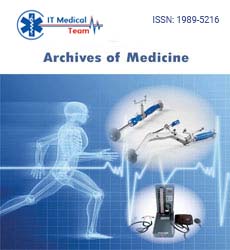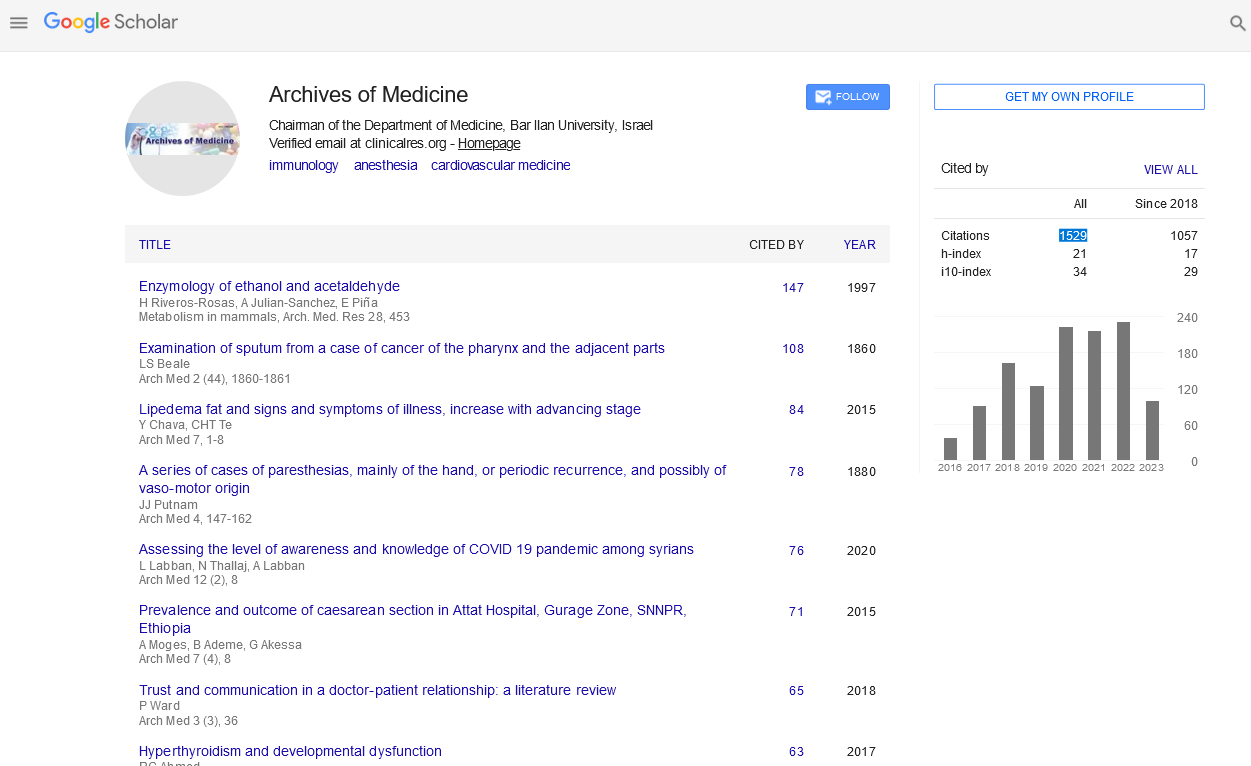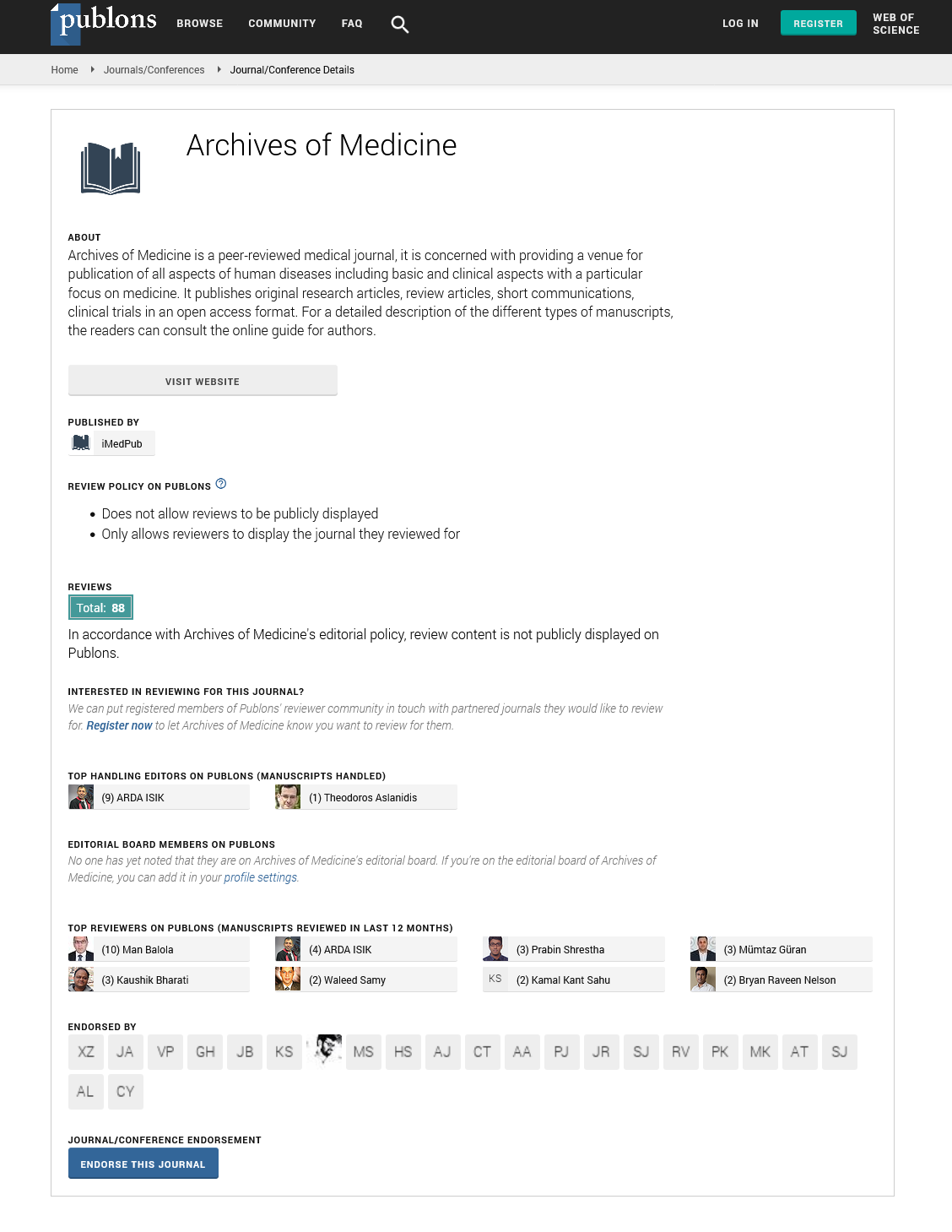Jose Maria Pereira de Godoy1*, Maria de Fatima Guerreiro Godoy2
1Professor Adjunct of Cardiology and Cardiovascular Surgery Department of the Medicine School in Sao Jose do Rio Preto-FAMERP, research CNPq (National Council for Research and Development), Brazil
2Teacher of the Stricto-Sensu of Post Graduation course of FAMERP and Clinical Research Group of the Godoy Clinic, Brazil
- *Corresponding Author:
- Jose Maria Pereira de Godoy
Adjunct of Cardiology and Cardiovascular Surgery
Department of the Medicine School in Sao Jose do Rio Preto-FAMERP
research CNPq (National Council for Research and Development)
Brazil Avenida Constituicao 1306, Sao Jose do Rio Preto, SP, Brazil
Tel: 551732326362
E-mail: godoyjmp@gmail.com
Received date: October 17, 2015; Accepted date: November 13, 2015; Published date: November 20, 2015
Citation: Wieckowska AG, Siwiec-Proscinska J, Dmitriew A, et al. Amblyopia Detection and Treatment across Poland-Results of a Questionnaire. Arch Med. 2015, 8:1.
Aim: The aim of this study was to evaluate epidemiological data and mortality of patients with anaerobic infections submitted to amputations.
Methods: In retrospective study of cohort were evaluating patients who underwent amputations due to anaerobic infections in the period from January 1998 to January 2008 were evaluated in a retrospective, quantitative observational study. The data were obtained from computerized hospital records with inclusion criteria being gas gangrene identified by signs of crepitation in the subcutaneous tissue during the physical evaluation and indications of gas on x-rays of the limb. Epidemiological data, such as gender, age, death, the level of amputation and diabetes mellitus were analyzed. The Fisher Exact test was utilized for statistical analysis with an alpha level of 5%.
Results: One hundred and ten patients were diagnosed with gas gangrene, 66 (60%) of of 87 of these patients (79%) had diabetes and 30 (27.3%) patients died. A total of 2809 patients were submitted to amputations for other reasons with 89 death. Patients with anaerobic infections had a significantly higher mortality rate that patients submitted to amputations for other reasons.
Conclusion: The death rate is higher in patients with gas gangrene and associated to the presence of diabetes mellitus who required surgical procedures.
Keywords
Gas gangrene, Amputation, Diabetes mellitus, Mortality, Infection
Introduction
Gas gangrene is a necrotizing soft tissue infection characterized by muscular necrosis and the formation of gas. It develops quickly and can cause septic shock and death. In adults, gas gangrene used to be a well-known complication of war wounds [1]. Clostridium perfringens and Clostridium septicum are the major etiological agents of traumatic and spontaneous gas gangrene, respectively [2].
There are a number of factors that predispose to the spread of these soft tissue infections, such as delays in diagnosis, immune suppression, diabetes mellitus and advanced age [3]. Reduced tissue perfusion leading to tissue ischemia is a central component of the pathogenesis of myonecrosis caused by Clostridium perfringens [4]. Characterized by extensive tissue necrosis and an absence of accompanying leukocyte infiltration and tissue inflammatory response, the histopathological picture of clostridial gas gangrene is distinctly different from other bacterial infections [5]. Poor blood flow due to arterial occlusion exacerbates the anaerobic condition [6].
Studies have shown high rates of death varying from 22.6% to 42.9% [7-9]. In victims of traumatic injury, the infection can become well established in as little as 6 to 8 hours and the destruction of adjacent healthy muscle can progress several inches per hour despite appropriate antibiotic coverage [10].
The use of broad-spectrum antibiotics tends to mask the severity of the underlying infection, modulates the clinical presentation, and even delays hospital admission. The most important factor affecting outcome in necrotizing soft tissue infection is early diagnosis and aggressive radical surgical treatment [4,10]. The aim of this study was to evaluate epidemiological data and death in patients with anaerobic infections who required surgical procedures.
Methods
In retrospective study of cohort was evaluating patients submitted to amputations due to anaerobic infections in the period from January 1998 to January 2008 in Hospital de Base in Sao Jose do Rio Preto.
Data were obtained from computerized hospital records identified using International Classification of Diseases, 9th Revision codes for amputation. Gas gangrene was diagnosed by signs of crepitation in the subcutaneous tissue during the physical examination and indications of gas on the X-rays of the limb. All other reasons for amputation were excluded; these patients served as a basis to compare death rates after amputation. Epidemiological data including gender, age, death, the level of amputation and diabetes mellitus were collected. Patients were considered diabetics when their hospital record included the results of a blood sugar test identifying the disease. All the patients were prescribed broad-spectrum antibiotics including gentamicin, clindamycin and ciprofloxacin. Cultures and antibiograms of the tissues were performed and the antibiotic therapy was considered adequate according to the results of these tests. Data were input on a Microsoft Excel spreadsheet and statistically analyzed. All patients were submitted to amputation on the same day as the diagnosis of anaerobic infections.
This study was approved by the Research Ethics Committee of FAMERP. The Fisher Exact test was utilized for statistical analysis with an alpha level of 5% (p-value < 0.05) being considered acceptable.
Results
One hundred and ten patients were diagnosed with gas gangrene, 66 (60%) of whom were men with ages varying between 25 and 85 years old (mean age 65years) and 44 (40%) were women with ages ranging between 43 and 101 years old (mean age 70.9 years). Eighty-seven (79%) of these patients had diabetes and 30 (27.3%) patients died.
A total of 85 major amputations, 35 minor amputations and 2 debridements were performed. Nine patients underwent two surgical procedures (major amputation following minor amputation) and one patient underwent 4 procedures. A total of 2809 patients were submitted to amputations for other reasons and in this subset of patients, 89 died. Patients with anaerobic infections had a significantly higher mortality rate compared to patients submitted to amputations for other reasons (Fisher exact test: p-value=0.0001).
Discussion
The current study shows that amputations due to anaerobic infections are associated to a higher mortality rate compared to amputations for other reasons. Additionally, these infections have a significant association with diabetes mellitus. Although an aggressive conduct is carried out to urgently eliminate the focus of the infection, the death rate of these patients remains high demonstrating the severity of the disease. Another important aspect is the association of diabetes mellitus in 79% of the cases. In the current study, specific cultures for the anaerobes were not performed; this could help to identify the agents responsible for the most aggressive gas gangrene.
One study reported high mortality rates of around 40% and warned about the rapid progress of infection even after the earliest possible conduct [11]. Ischemia of the limb may exacerbate the progression of the infection and constitutes an aggravating factor [6]. Infection by non-clostridial gas gangrene in multiple injury patients produces a mortality rate of 42.9% [7]. A mortality rate of 62.5% was reported in patients with infections by Aeromonas associated with gas gangrene in Okinawa, Japan [12].
Critical limb ischemia, neuropathy and an immunocompromised host, which often are associated with diabetic foot infections, complicate treatment and are associated with a poorer prognosis [13-15]. Outhers aspect is that patient underwent lower-limb amputation had a high mortality during for next years [16].
Clostridium septicum is a highly virulent causative agent of spontaneous gas gangrene induces irreversible cellular injury and a marked reduction in microvascular perfusion [4]. Clostridium perfringens, causes clostridial myonecrosis or gas gangrene in humans by producing numerous extracellular toxins and enzymes that act in concert to degrade host tissue [17].
The team practices medicine and the radiologists must be aware of abnormal gas in soft tissue because it may be the main or unique sign leading to an underlying pathology, which can be lethal.
Conclusion
The death rate is higher in patients with gas gangrene and associated to the presence of diabetes mellitus who required surgical procedures.
Consent Form
The study has approved the protocol for any investigation involving humans or animals and that all experimentation was conducted in conformity with ethical and humane principles of research of Medicine School of São Jose do Rio Preto-Brazil- FAMERP.
7931
References
- de Godoy JM, de Godoy MF, Batigalia F, Trávolo AR, Monteiro EH (2005) Lower-extremity amputation: a 6-year follow-up study in Brazil. J OrthopSurg (Hong Kong) 13: 164-166.
- Hickey MJ, Kwan RY, Awad MM, Kennedy CL, Young LF, et al. (2008) Molecular and cellular basis of microvascular perfusion deficits induced by Clostridium perfringens and Clostridium septicum. PLoSPathog 4: e1000045.
- Kennedy CL, Lyras D, Cheung JK, HiscoxTJ, EmminsJJ, et al. (2009) Cross-complementation of Clostridium perfringens PLC and Clostridium septicum alpha-toxin mutants reveals PLC is sufficient to mediate gas gangrene. Microbes and Infection 11: 413-418.
- Korhonen K, Klossner J, Hirn M, Niinikoski J (1999) Management of clostridial gas gangrene and the role of hyperbaric oxygen. Ann ChirGynaecol 88: 139-142.
- Lu J, Wu XT, Kong XF, Tang WH, ChengJM, et al. (2008) Gas gangrene without wound: both lower extremities affected simultaneously. American Journal of Emergency Medicine 26: 970.e3-e4.
- Nakasone I, Yamane N, Miyazaki T, Onaga S, Higa M (2001) Aeromonas species infection with severe clinical manifestation in okinawa, Japan - Association with gas gangrene. RinshoBiseibutshuJinsokuShindanKenkyukai Shi 12: 15-21.
- Niimi M, Ikeda Y, Kan S, Takami H (2002) Gas gangrene in patient with atherosclerosis obliterans. Asian CardiovascThorac Ann 10: 178-180.
- O'Brien DK, TheritBH, Woodman ME, Melville SB (2007) The role of neutrophils and monocytic cells in controlling the initiation of Clostridium perfringens gas gangrene. FEMSImmunol Med Microbiol 50: 86-93.
- Ohtani K, Yuan Y, Hassan S, Wang R, Wang Y, et al. (2009) Virulence gene regulation by the agr system in Clostridium perfringens. J Bacteriol 191: 3919-3927.
- Paramythiotis D, Koukoutsis H, Harlaftis N (2007) Necrotizing soft tissue infections. Surgical Practice 11: 17-28.
- Pereira de Godoy JM, VasconcelosRibeiro J, Caracanhas LA (2008) Mortality and diabetes mellitus in amputations of the lower limbs for gas gangrene: a case report. Int J Low Extrem Wounds 7: 239-240.
- Stevens DL, Bryant AE (2002) The role of clostridial toxins in the pathogenesis of gas gangrene. Clin Infect Dis 35: S93-93S100.
- Takahira N, Shindo M, Tanaka K, Soma K, Ohwada T, et al. (2002) Treatment outcome of nonclostridial gas gangrene at a Level 1 trauma center. J Orthop Trauma 16: 12-17.
- Mulder G, Tenenhaus M, D'Souza GF3 (2014) Reduction of diabetic foot ulcer healing times through use of advanced treatment modalities. Int J Low Extrem Wounds 13: 335-346.
- Zenelaj B, Bouvet C, Lipsky BA, UçkayI3 (2014) Do diabetic foot infections with methicillin-resistant Staphylococcus aureus differ from those with other pathogens? Int J Low Extrem Wounds 13: 263-272.
- Tsokos M, Schalinski S, Paulsen F, Sperhake JP, Puschel K, et al. (2008) Pathology of fatal traumatic and non-traumatic clostridial gas gangrene: A histopathological, immunohistochemical, and ultrastructural study of six autopsy cases. Int J Legal Med 122: 35-41.
- Zgonis T, Stapleton JJ, Girard-Powell VA, HaginoRT (2008) Surgical management of diabetic foot infections and amputations. AORN J 87: 935-946.






